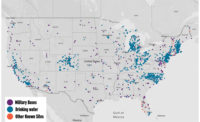Lawsuits and environmental cleanups are expected to grow exponentially for producers and even users of some 7,000 per- and polyfluoroalkyl substances, known collectively as PFAS, as more states set exposure limits and Biden administration regulators weigh specific drinking water rules or declare as hazardous substances the chemicals with wide business and consumer use in products.
The Orange County, Calif., water district and 10 cities and local utilities, facing what they claim is a $1-billion-plus cleanup of surface water and groundwater PFAS sources, filed suit last month in state court against chemical makers 3M, Dupont and others.
The suit cites perfluorooctanesulfonic acid (PFOS), and perfluorooctanoic acid (PFOA)—both fluorinated compounds in the PFAS family that repel oil and water. Utilities also claim in the suit that DuPont shed more than $20 billion in assets through corporate restructuring to shield liability.
Setting Limits
California has set response levels for the two compounds at 40 parts per trillion for PFOS and 10 ppt for PFOA. Seven other states have also set limits, and four have proposed them.
The U.S. Environmental Protection Agency has not set an enforceable curb but considers the compounds “contaminants of emerging concern,” and has suggested a 70-ppt limit. “Most states have a 10 ppt to 20 ppt limit, but we expect an EPA drinking water limit this year,” John Gardella, an attorney at Boston-based CMBG3 Law, tells ENR.
PFAS are ubiquitous and considered a “forever chemical” that never dissipates. They are used in thousands of products, including such construction materials as cement additives, architectural membranes, paints, glass surfaces, sealants, sheet rock, coatings on piping, solar cells and flame retardants. “The question now is what can we do to be safe,” says construction law firm partner Brett Renton. The science behind cleanup is now being developed, he says.
More Testing
Safer States, a state-driven group advocating for reduced PFAS exposure, estimates that one-third of Americans drink water contaminated with PFAS, which will grow as more systems are tested.
Michigan was first, in 2018, to conduct comprehensive PFAS testing of public water supplies, detecting chemicals in 120 systems, says the Sierra Club.
The Orange County suit named large chemical producers as defendants, but also included DECRA Roofing Systems, which makes roofing products with PFOAs purchased from 3M. Observers believe the roofing firm’s inclusion is one of the first actions of its kind.
Gardella expects product liability to be the next PFAS litigation wave, citing a class-action settlement Jan. 12 with Johnson Controls to clean up contaminated drinking water wells in Wisconsin. The $17.5-million pact, while relatively small, is considered a “milestone,” he says.
Orange County’s suit followed one in October by the Santa Clarita Valley Water Agency in California against 3M, DuPont and Chemours for introducing PFAS into the water system from nearby production sites.
The suit—which seeks compensation for treatment, testing, removal and disposal of PFAS—also could involve millions in damages for state-of-the-art PFAS filtration systems. The agency found PFAS in 17 wells, which triggered notification to other utilities, says Gardella. Santa Clarita Valley completed a $6-million groundwater PFAS treatment plant in October. Three more are expected to open in 2022.
That suit was added to the multidistrict litigation, or MDL, set up in U.S. district court in Greenville, S.C., that so far includes 760 consolidated PFAS cases.
Some involve aqueous film forming foam, or AFFF. The Federal Aviation Administration mandates airports to continue use of AFFFs, but Congress in 2018 said the agency must stop mandating AFFF this year.
“FAA hasn’t identified a substitute,” says one attorney. Airports must install systems to keep material from migrating into water tables. The U.S. Defense Dept. says it will cost $33 billion to clean up site PFAS and AFFF toxics, and the department must stop using firefighting foam by Oct. 1, 2024. New Jersey on Jan. 14 filed suit against the U.S. government and military for PFAS impacts from bases in the state.
Manufacturers Comment
DuPont and 3M dispute claims in the California lawsuits and promise “vigorous” defenses of their positions, say spokesmen. “3M has invested more than $200 million globally on PFAS remediation efforts, including more than $50 million toward installing carbon filtration systems for drinking water sources,” says a company statement.
“There are only a handful of incinerators hot enough” to burn PFAS chemicals, says Renton, but he questions whether substances are destroyed “or launch it into the atmosphere.”
EPA on Dec. 18 released for public comment interim guidance on destroying or disposing of PFAS-containing materials in non-consumer products. It describes thermal treatment, landfill and underground injection.
Industry observers also expect to see PFAS chemicals designated as a hazardous waste with a discharge limit determined under CERCLA, the federal Superfund authorizing law, as early as next year. “EPA has signaled it has a draft rule ready,” says attorney Gardella.





Post a comment to this article
Report Abusive Comment